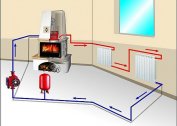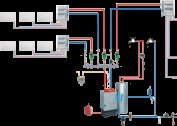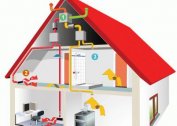Thanks to the rapid development of the alternative energy field, private residential premises were actively equipped with such equipment. These systems include heat pumps (VT) "air-to-air." However, before buying a compressor, which is the main element of the system, it is advisable to familiarize yourself with the principle of operation and the installation rules of heat pumps.
The uniqueness of the equipment lies in the fact that it takes heat directly from the atmosphere, which can significantly reduce the cost of heating a house. The heat pump carries out the "intake" of air from the street, as well as from the room, after which it distributes the air masses over all objects of the structure. At the same time, there is no need to purchase combustible types of fuel. In its appearance, the air-to-air VT is very similar to an inverter air conditioning system.
Principle of operation
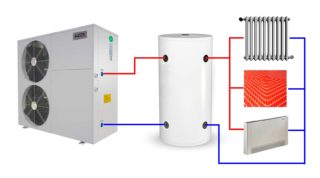 The composition of heat pumps of this type includes the following components:
The composition of heat pumps of this type includes the following components:
- compression unit;
- an evaporator equipped with a special fan, with the help of which forced blowing is performed;
- expansion valve;
- tubes made of high-quality copper (with their help, freon moves between the street space and the cottage);
- a condenser by means of which heated air is distributed over the residential and non-residential premises of the object.
After using the fan, air flows from the street into the system, they pass through the fins of an external evaporator. Freon uses the received heat energy, gradually turning into a gas state. After that, the gaseous substance enters the capacitor. Getting into the tubes of copper, the gas moves to the internal unit of the system.
As soon as the freon enters the condenser located in the interior of the house, it "turns" back into a liquid state, due to which the transfer of warm streams into the interior of all rooms of the house takes place. An expansion valve is required to relieve excess pressure.
Advantages of air-to-air heat pumps
 The growing demand for such systems of heating and cooling air masses is annually due to their main advantages:
The growing demand for such systems of heating and cooling air masses is annually due to their main advantages:
- the versatility of VT allows for the heating and cooling process in commercial, municipal, industrial and residential buildings;
- since the systems do not use any combustible fuel, they are much more environmentally friendly than similar units;
- if you have experience in installing such devices and special tools, you can install a fuel pump of this type on your own in the shortest possible time;
- the equipment has a high coefficient of heat transfer and does not require special costs for regular maintenance;
- reasonable price of VT allows you to buy a factory system for people with almost any monthly income;
- a minimum amount of time is spent on compressor maintenance;
- for the manufacture of devices combustible materials are not used, and for work - fuel, which allows us to talk about their complete fire safety.
According to the reviews of those who have already installed the air-to-air fuel pump and numerous experts, equipment rarely fails before the end of the warranty period. In addition, VTs are distinguished by maintainability and low cost of parts and components. Management and control of the system is automated.
A few minor flaws
 If we talk about leaving, it is enough to regularly clean the air companies and replace them as they become dirty.Of course, the disadvantages of fuel pumps of this type are few, but they still have:
If we talk about leaving, it is enough to regularly clean the air companies and replace them as they become dirty.Of course, the disadvantages of fuel pumps of this type are few, but they still have:
- in the process of functioning, they make a little noise, which is extremely inconvenient if an infant lives in the house;
- the heat transfer coefficient directly depends on the ambient temperature outside the windows of the object;
- in the cold season, the amount of electricity consumed by the system increases;
- in the process of continuous operation of the compressor on the device, a large number of tiny particles of dust gradually accumulate;
- to ensure the smooth operation of the equipment, you will need to additionally buy a generator.
According to tests, the equipment copes with its functions perfectly, while the temperature outside the windows does not drop to -10 ° C. The lower the temperature, the lower the efficiency of the system. That is why if the VT is selected to heat a building located in a cold climate zone, it will be additionally equipped with a boiler or fireplace.
How heat pumps differ from air conditioning systems
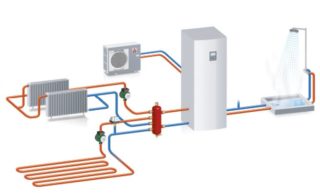 Despite the fact that in appearance the heat pumps are similar to ordinary air conditioners, there are a number of significant differences between them. Firstly, unlike the air conditioner, the VT can be used to heat rooms all year round. Secondly, it is desirable to use air-to-air systems only for heating purposes, since they are ineffective for cooling.
Despite the fact that in appearance the heat pumps are similar to ordinary air conditioners, there are a number of significant differences between them. Firstly, unlike the air conditioner, the VT can be used to heat rooms all year round. Secondly, it is desirable to use air-to-air systems only for heating purposes, since they are ineffective for cooling.
Thirdly, VTs spend much less electric energy than household air conditioners. Fourth, heat pumps are environmentally friendly and use exclusively renewable sources of thermal energy, namely, ambient air.
Most often, such devices heat homes built from natural wood or SIP panels. VTs have optimal capacities to provide heating for precisely such structures. In addition, they pay off in the shortest possible time, since they need a minimum of electricity. Of course, if you purchase apparatus for heating buildings in harsh climates, you will have to buy additional equipment - a generator and a boiler. Without knowledge in the installation of these systems, it is better to entrust this matter to qualified specialists.
